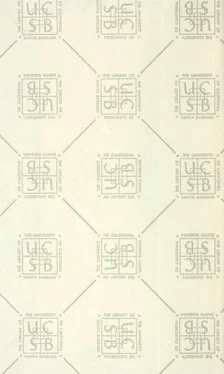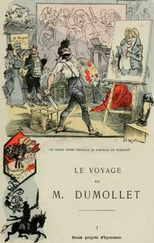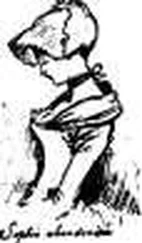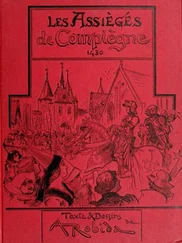Albert Robida - Yester-year; ten centuries of toilette from the French of A. Robida
Здесь есть возможность читать онлайн «Albert Robida - Yester-year; ten centuries of toilette from the French of A. Robida» весь текст электронной книги совершенно бесплатно (целиком полную версию без сокращений). В некоторых случаях можно слушать аудио, скачать через торрент в формате fb2 и присутствует краткое содержание. Жанр: Старинная литература, на английском языке. Описание произведения, (предисловие) а так же отзывы посетителей доступны на портале библиотеки ЛибКат.
- Название:Yester-year; ten centuries of toilette from the French of A. Robida
- Автор:
- Жанр:
- Год:неизвестен
- ISBN:нет данных
- Рейтинг книги:4 / 5. Голосов: 1
-
Избранное:Добавить в избранное
- Отзывы:
-
Ваша оценка:
- 80
- 1
- 2
- 3
- 4
- 5
Yester-year; ten centuries of toilette from the French of A. Robida: краткое содержание, описание и аннотация
Предлагаем к чтению аннотацию, описание, краткое содержание или предисловие (зависит от того, что написал сам автор книги «Yester-year; ten centuries of toilette from the French of A. Robida»). Если вы не нашли необходимую информацию о книге — напишите в комментариях, мы постараемся отыскать её.
Yester-year; ten centuries of toilette from the French of A. Robida — читать онлайн бесплатно полную книгу (весь текст) целиком
Ниже представлен текст книги, разбитый по страницам. Система сохранения места последней прочитанной страницы, позволяет с удобством читать онлайн бесплатно книгу «Yester-year; ten centuries of toilette from the French of A. Robida», без необходимости каждый раз заново искать на чём Вы остановились. Поставьте закладку, и сможете в любой момент перейти на страницу, на которой закончили чтение.
Интервал:
Закладка:
It is she who is victorious. The sinews of war are employed in paying the King's troops, and providing arms and provisions, likewise in defraying the cost of the luxurious living of the Lady of Beauty, and her innumerable Avhims. " These," says an old romance, "ai'e also the expenses of war, since the king lights better when Agnes commands him."
That heroic maiden, the valiant Joan, donned her cuirass to lead dukes, lords, and men-at-arms to conflict ; the fair Agnes, adored by the king, worked for the national cause after a totally different fashion ; she bared her shoulders, invented bodices indecently cut down to the waist, and enlarged the great hennins with floating streamers. And the King's troops marched, taking castles, towns and provinces, and hunting out the English. Agnes may be said to have died on the field, for she expired near Juraièges during the reconquest of Normandy, whither she had followed the king.
The Court of Burgundy, which was the rival of the Court of Paris in display as well as in all other things, brought strange elements into French fashion, especially from Flanders. This importation inaugurated the last epoch in the costume of the Middle Ages, the final blaze, dazzle, and glitter of their strange and gorgeous attire.
The gigantic ' houppelande ' or mantle worn by both men and women resembles a large piece of tapestry—the outlines are lost in the complication of the design. After a period of transition the Renaissance was coming.
We might dwell on many other interesting and pretty things, features in the costume and general adornment of the women of the Middle Ages, in the ceremonial attire, made of splendid stuff, and with glittering garniture, in the indoor and outdoor clothinsf of all classes, as well as in the travelling and hunting dress worn by noble ladies who rode richly-caparisoned mules upon their journeys, or trained palfreys on their hawking parties, and carried jessed and hooded falcons on o-auntleted wrists.
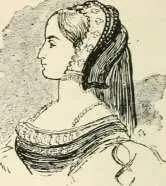
Uiitler Fraucis I.
IV.
THE RENAISSANCE.
The Fashion as to width—Hocheplis, and farthingales— La belle Ferronnière —Fans and Muffs—The gloomy fashions of the ' Reform '—Queen Catharine's 'Flying Squadron'—Laces and guipures—The stages of the farthingale—The mask and the nose-cover—Paints and cosmetics.
Immediately after the expeditions of Charles VIII. a gust arose, and blew upon the modes of the Middle Ages. The Gothic period had come to an end; the costume of men was
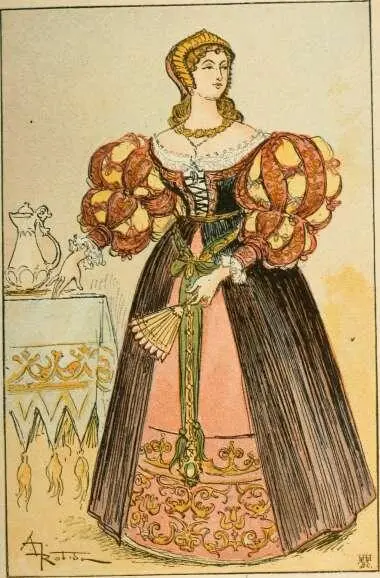
A LA COUR nu R()T-(:iii:vAi.ii:i.
suddenly transformed, and that of women was about to alter in its turn. That Avind carried away our national architecture and our national taste, with many other things, for instance, the hennin, which, in spite of appearances, became its wearers' heads so well that the mode had lasted for nearly a century.
Costume became less formal and more complicated. The corset or bodice superseded the surcoat ; it was low-cut, not of the same colour as the gown, and was laden with ornaments and gilded designs, while necklaces of several rows of beads or jewels covered the upper part of the neck. The sleeves again were of a different colour from the bodice ; and now we come to the great streaming, wing-like sleeves, with cut-out edges, and to sleeves made in several pieces fastened together by tags or ribbons, and showing the chemise of fine Friesland linen, puffed at the shoulders and elbows. This was the beo^inningf of the sleeves with alter-nate puffings and slashes, which were destined to last so long.
Toed, or square-ended shoes, succeeded long-pointed shoes ; for fashion always goes from one extreme to its opposite. There was great variety in head-dresses, but all were low. Turbans which covered the whole head, also coifs embroidered in gold that framed, so to speak, the forehead and the face, were much worn ; these turbans and coifs, ornamented with beaded nets, were modified in countries where Flemish or Rhenish influence contended with Italian influence, by the addition of a sort of slashed hat, which grew by degrees into the wide ' béret ' of the Swiss or German lance-bearers.
At this period a fashion arose which was adopted, alike by noble ladies and wealthy dames of the bourgeoisie, throughout the whole of the reign of Francis I., at the dazzling Court of the Knightly King, and also in the cities.
The chief innovation, destined to influence all the other garments, and j^^rtly to define their cut and proportions, and to be thenceforth the dominant note of costume, was the farthingale,^ This was a thincj hitherto un-known, a great novelty which upset the whole system of costume, and changed all its lines.
The farthingale, that is to say, the wide skirt supported by a contrivance of one kind or another, " came in," to stay " in " for three centuries. It lasted for three hundred years, with intervals of more or less duration under different names : panier, crinoline, pouf, tournure, bustle, dress-improver, &c. It still lasts, and we shall see it flourishing agjain.
For three hundred years the width of skirts runs a regular course ; it increases little by little, slowly, accustoming the eye progressively to its proportions ; it reaches a formidable, excessive, imjDOSsible expansion, then it de-
Vertngadin, vertugalle, or vertugardien.
creases gradually, passing the reverse way through all its former stages.
Women, whom the farthingale has trans-
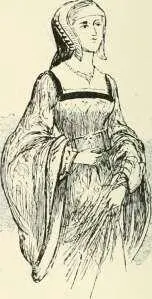
Begiuuiug of the Renaissance.
formed for a shorter or longer period into big bells, become once more little bells, 'small by degrees, and beautifully less,' until the farthingale is suj)posed to have vanished.
THE KENAISSANCE Gl
For some years very clinging garments are worn, then just an insinuation of bustle reappears, a little touch of farthingale is discernible in skirts, and the inevitable process begins once more.
The farthingale triumphs still, in spite of the unsparing abuse, the comic songs, and the increasing ridicule lavished upon it ever since its invention, and even in spite of the edicts which attempted to reduce its dimensions. No power in the world has had so many enemies arrayed against it, no institution has been so vigorously and eagerly attacked.
Monarchy and Republicanism have adversaries, but they have advocates also. The farthingale, whether as panier or crinoline, had every husband, every man against it. The corset only competes with it in the multitude of its enemies—and the corset also has invariably beaten them.
The farthingale, which came into existence under Francis I., about 1530, marks the end of the Middle Ages more clearly and completely than any political change whatsoever marks it. The clinging or hanging gown, with its straight sculptured lines, has disappeared. A world is ended.
The farthingale was at first known as the ' hocheplis,' or shake-folds. This name was applied in the first instance solely to a stiffened pad, stretched upon a wire frame, which was attached to the waist to give width to the skirts. Afterwards the name was extended to a construction of cane or whalebone, forming a cage under the petticoat.
The costume of women in the reign of Francis I. was ample and majestic rather than graceful; gowns were made of velvet, satin, and flowered brocatelle, of various colours, with wide hanging sleeves, lined with sable, or enormous puffed sleeves raised over the shoulder, and forming a succession of rolls down to the wrists, with slashes showing puffs of lii^ht silk.
Читать дальшеИнтервал:
Закладка:
Похожие книги на «Yester-year; ten centuries of toilette from the French of A. Robida»
Представляем Вашему вниманию похожие книги на «Yester-year; ten centuries of toilette from the French of A. Robida» списком для выбора. Мы отобрали схожую по названию и смыслу литературу в надежде предоставить читателям больше вариантов отыскать новые, интересные, ещё непрочитанные произведения.
Обсуждение, отзывы о книге «Yester-year; ten centuries of toilette from the French of A. Robida» и просто собственные мнения читателей. Оставьте ваши комментарии, напишите, что Вы думаете о произведении, его смысле или главных героях. Укажите что конкретно понравилось, а что нет, и почему Вы так считаете.
